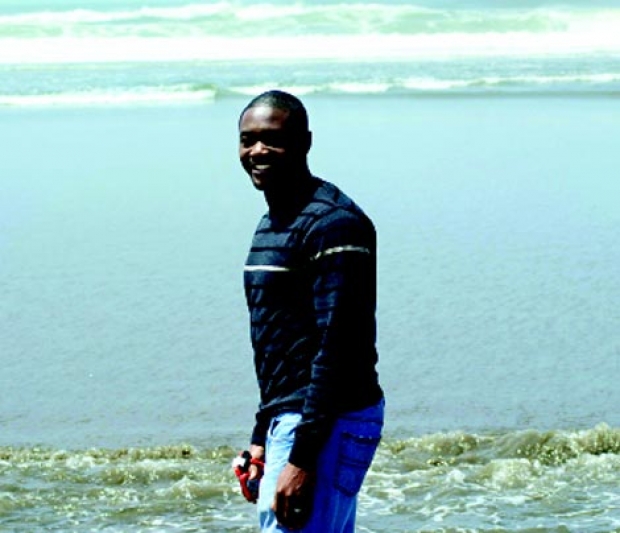Charles E. Williams returns to the Grand Strand as artist-in-residence at the Pawleys Island Festival of Music and Art

With the current state of the economy, making a living as an artist may seem about as likely as winning the lottery. However, Georgetown native Charles E. Williams is living proof that the right combination of ambition, talent and hard work can yield success even in the most unlikely of professional callings.
Williams recalls visiting Barnes & Noble with his mother as a boy, gazing at the art magazines and wondering how in the world he might land his work on their pages. Two decades later, his landscape paintings have earned him the cover of Composite Arts Magazine and Professional Artists Magazine—in addition to a Hudson River Fellowship, a listing as one of the “21 Emerging Under 31” by Southwest Art Magazine and a slot as exclusive artist at Robert Lange Studios in Charleston. Evidently he figured it out.
Williams will bring his talent here this fall when he serves as artist-in-residence at the Pawleys Island Festival of Music and Art. In addition to a showing and live demonstration of his work, Williams will teach art classes at Waccamaw Elementary and Middle schools.
This artist’s career path has been far from predictable and linear, but his passion and determination to succeed have been consistent throughout. After graduating from Georgetown High School, he attended Savannah College of Art and Design (SCAD), earning a degree in 2006. Then he moved to Tampa, where he worked at a graphic design studio.
“I had that job for three years; I was coming home at 5 and then painting until 1 in the morning,” recalls Williams. “One day, I said, ‘I need more time.’ My dad gave me the push to take that leap, and I haven’t looked back since.”
Part of the leap to make it as a full-time artist included setting his sights on a specific studio and working to make his dream come true. “I wanted to get into [Charleston’s] Robert Lange Studios,” says Williams. “I would drive eight hours to their First Friday art walks, and I insisted to myself, ‘I will be in this gallery one day.’ Finally they gave me a group show, and I brought a marsh scene with a drip at the bottom. It sold that night, and I sold two more the next day.” Suddenly, Williams’ career shot into overdrive.
The “drip” to which Williams refers has become a signature technique in his works, making his style a fusion of traditional and contemporary. Williams’ landscape scenes originate from Lowcountry locales like Pawleys Island, Folly Beach, Hilton Head and the Black River, and they typically incorporate bodies of water, trees, sky, marsh grass and reflections on water. The representation of reality in his works has received high praise from critics, but the technique of using drops and splatters around the edges brings a new dimension—literally—to his paintings. Critic Teia Pearson writes in the “Escape Into Life” online arts journal, “The effect is striking, highlighting both our perceptions of three-dimensional scenes on a two-dimensional surface, and Williams’ skills as a realist painter.”
Williams credits many Grand Strand artists and business people with offering inspiration and support as he embarked on his journey to a successful career. Waccamaw Intermediate School art teacher Christy Weaver was Williams’ own instructor in first and second grade when he attended Kensington Elementary, and she’s remained a mentor and friend ever since. “She really influenced me, growing up, and for me to be 28 and still talking to her two to three times a week—she’s like a second mom,” Williams says. When Williams was in high school, he approached Weaver with his goal of attending SCAD, and she gathered community arts leaders including Linda Ketron, Scott Blaylock and Vida Miller, who helped raise awareness of Williams’ work and funds for his scholarship.
More recently, Weaver was instrumental in bringing Williams’ work to the attention of a local gallery owner, eventually leading to his solo show at the Cheryl Newby Gallery in June 2011. “I had known about [Williams] for a couple of years, but Christy Weaver is the one who brought him to my gallery—totally unexpected—and introduced him to me; she was the moving force in putting the event together,” says Cheryl Newby.
Williams returns to the Grand Strand and strengthens his bonds on a regular basis. When he teaches at the Waccamaw schools this fall, it won’t be for the first time; he’s worked with Weaver’s students twice before. “He’s a giver,” says Weaver. “He really gives back; that is what has impressed me the most. He gives up his time when he could be painting and getting ready for a show to share his talents and wonderful personality with students.”
The journey from first-grade art student to internationally acclaimed painter has been a long and winding road, one that ends as a brilliant success story. And Williams is taking it all in stride. “I look back and I’m like, ‘Whoa!’ I’m very blessed.”